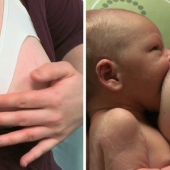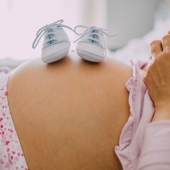Birth is the Mount Everest of physical functions in mammals. Your uterus is a very strong muscle. And your uterus is contracting. Like, giving a big hug to your baby. And squeezing your baby so that your baby can move further down, and be born. There's all kinds of hormones, and different things that are happening to encourage this process.
Labor is broken up into different stages. You have the first stage of labor, which involves early active and transition. And then you have the second stage of labor, which involves the pushing when your baby is born.
In the first stage of labor, your cervix, which is the opening to your uterus, almost like a bottle. You picture a bottle and you have the neck of the bottle. The cervix is the opening to the uterus. And the cervix, throughout labor, thins and dilates. That thinning process is called effacement. And during effacement, the cervix thins out. They measure it in percentage. So it starts about, like, this size, and it thins out. Like, if you can imagine sucking on a mint. As the mint gets thinner, it then can grow to become a little bit wider. The dilation is measured in centimeters. So you can start your early labor. Can start with your cervix anywhere from 0 to typically 3 centimeters. When your cervix is fully effaced and fully dilated, the time has come for you to push.
For pushing, the second stage of labor. That is broken up into different stages as well. So you have the descent phase, when your baby comes down, that your baby is measured in different stations. Your baby can start at -3, -2, -1. At zero station, it's when your baby is aligned with the ischial spines of your pelvis. And then it moves down into +1, +2, and +3. When your baby's head has reached the +3 station, then the crowning begins. This can be a very intense time during birth. And you'll want to make sure to breathe slowly. Really follow the direction of your care provider, and know that your baby is almost here.
The third stage of labor is the delivery of the placenta. This usually happens between 5 and 25 minutes after giving birth. And you'll really want to take some time during that time, spending the moments with your baby. Having immediate skin to skin contact. The oxytocin hormone flowing through your system at this point, when you're so in love with your baby and really connecting with your baby, will help your uterus to continue to contract and expel the placenta.
The fourth stage of labor is often considered the post-partum period. This is from the time that you've given birth up until 6 weeks. During this time, you'll be focusing on falling in love with your baby, connecting with your partner. Learning how to parent your newborn. And learning how to take basic care of your new baby.
So a lot of women ask me, how long am I going to be in labor? A first-time Mom can be in labor anywhere from 1 hour, which is pretty rare that it happens that quickly, up to about 24 hours. Now, keep in mind, this is not always 24 hours of intense sensation. Remember, labor goes from early labor, to active labor, to transition, then to pushing.
- 6490 views













